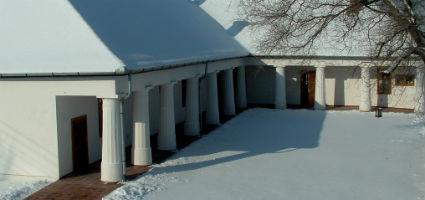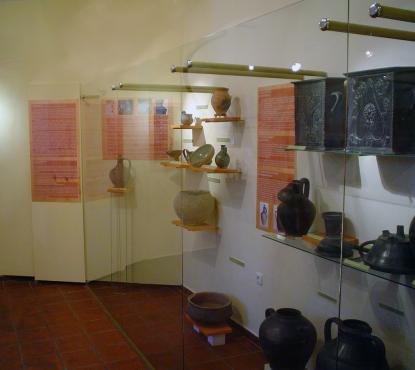2025. December 13. Saturday
Túr Pottery Museum - Mezőtúr
 |
Address: 5400, Mezőtúr Bajcsy-Zsilinszky E.út 41.
Phone number: (56) 350-174
E-mail: fazekasmuzeum@gmail.com
Opening hours: 01.10-31.03.: Tue-Fri 10-12, 14-16, Sat 10-14
01.04-30.09.: Tue-Sun 10-12, 15-17 |
Museum tickets, service costs:
|
Ticket for adults
|
260 HUF
|
|
|
Ticket for students
|
130 HUF
|
|
|
Ticket for pensioners
|
130 HUF
|
|
|
Guide
|
2000 HUF
|
The permanent exhibition follows the history of potter's craft in the region from the 18th century to nowadays.

Documents prove that potters surely worked in town even in the 16th century. They formed guilds towards the end of the 18th century and more and more potter workshop opened in town. The most popular pottery was black pottery without enamel. A typical product was a jug after which the potters were named. The use of enamel probably came from Hódmezővásárhely.
The heyday of potters of Túr was in 1870-1890. The light yellow so-called 'dudi' pottery was begun to be made around that time. The coloring came from the village Dud from Arad County.
The end of the 19th century was the period of secession in Mezőtúr. The potter Badár Balázs (1855-1939) was one of the greatest figures of Hungarian pottery art. The master with excellent professional knowledge realized the necessity of changes. Instead of tools used by the peasantry, he began to make objects for the civic society. Soon he was known in Hungary and Europe. He won several prizes from Budapest to Paris.
In the beginning of the 20th century, the center of potter's craft was in critical situation. Despite the difficulties, several beautiful and valuable ceramics came out of the workshops of Csibi Ferenc, Cs. Kiss Imre and Varga Gábor. The crisis lasted up to the 1950's.
The changes came with the establishment of the Agyagipari Coop. The coop system solved the problem of marketing. Exigent work was performed in the workshops based on tradition. Today 8-10 workshops are run in town.
The permanent exhibition shows ceramics of all eras illustrated with pictures and moving pictures, as well as texts. The captions are in Hungarian, English and German. We also await our visitors with temporary exhibitions.

Documents prove that potters surely worked in town even in the 16th century. They formed guilds towards the end of the 18th century and more and more potter workshop opened in town. The most popular pottery was black pottery without enamel. A typical product was a jug after which the potters were named. The use of enamel probably came from Hódmezővásárhely.
The heyday of potters of Túr was in 1870-1890. The light yellow so-called 'dudi' pottery was begun to be made around that time. The coloring came from the village Dud from Arad County.
The end of the 19th century was the period of secession in Mezőtúr. The potter Badár Balázs (1855-1939) was one of the greatest figures of Hungarian pottery art. The master with excellent professional knowledge realized the necessity of changes. Instead of tools used by the peasantry, he began to make objects for the civic society. Soon he was known in Hungary and Europe. He won several prizes from Budapest to Paris.
In the beginning of the 20th century, the center of potter's craft was in critical situation. Despite the difficulties, several beautiful and valuable ceramics came out of the workshops of Csibi Ferenc, Cs. Kiss Imre and Varga Gábor. The crisis lasted up to the 1950's.
The changes came with the establishment of the Agyagipari Coop. The coop system solved the problem of marketing. Exigent work was performed in the workshops based on tradition. Today 8-10 workshops are run in town.
The permanent exhibition shows ceramics of all eras illustrated with pictures and moving pictures, as well as texts. The captions are in Hungarian, English and German. We also await our visitors with temporary exhibitions.
|
Related activities
|
|
